Reason to trust

How Our News is Made
Strict editorial policy that focuses on accuracy, relevance, and impartiality
Ad discliamer
Morbi pretium leo et nisl aliquam mollis. Quisque arcu lorem, ultricies quis pellentesque nec, ullamcorper eu odio.
In the past year, the cryptocurrency market has seen an unprecedented outbreak. For the purpose of managing liquidity and volatility, the importance of stablecoin has become apparent, not only in the centralized market, but also in the decentralized stablecoin market, which has seen rapid growth in the past year.
Strong Demand for Decentralized Stablecoin
The growth in demand for decentralized stablecoins is partly due to the opaqueness and controversy surrounding the regulation of centralized stablecoins and users have stronger needs to seek alternatives. On the other hand, the DeFi market has witnessed an outburst in the past year, the traditional centralized stablecoins obviously has its limitations circulating in the DeFi market, making decentralized stablecoins the preferred choice of most DeFi users.
Dai is the fastest growing decentralized stablecoin in the last 12 months. In the last 12 months, total DAI supply has grown by 46x and has generated over $63 million in net revenue since 2021, with total DAI supply now exceeding $5 billion, making MakerDao the most successful decentralized stablecoin lending protocol in the market.
Just as there are different types of stablecoins in centralized stablecoins such as USDT and USDC, different public blockchains are in need of their own decentralized stablecoin protocols to ensure the diversity and security of the network’s stablecoins, in order to prevent losses to users of other networks due to policies, environment and security on a separate public blockchain.
Besides, other public blockchain networks have developed rapidly in the past year. Take HECO as an example, as public blockchain, Heco has a TPS speed of 500+, a block generation rate of 3 seconds and uses HPoS consensus mechanism, Offering features such as low transaction cost, low transaction latency and high transaction concurrency, etc., HECO has attracted a large number of users and projects since entering 2021.
As of now, HECO’s on-chain ecosystem is in urgent need of its own decentralized stablecoins. Looking into the future, HECO’s online traffic and projects will continue show momentum of growth and the potential is promising. That is the environment in which Demeter is born.
Demeter is a decentralized cryptocurrency market protocol on HECO. Similar to MakerDao, Demeter also has both collateral lending and collateralized stablecoin generation capabilities, providing users with a more robust stablecoin (DUSD) at a lower cost and a more secure lending service.
Two Ecosystems of Demeter
Demeter’s ecosystem can be divided into two main categories: Supply & Borrow, and stablecoin.
Supply & Borrow
Unlike traditional decentralized lending protocols, Demeter has introduced innovations to the interest rate model and collateral ratio of the DeFi lending protocol. Particularly for the establishment of credit grading model, Demeter incorporates and grades all existing crypto assets, introduces a richer type of crypto assets such as LP assets, collateral assets NFT-fi, etc., making the lending model between currencies highly compatible under the premise of ensuring security, controlling interest rate and volume through smart contracts, and providing maximum convenience for users, which is a unique innovation made by Demeter in response to market demand.
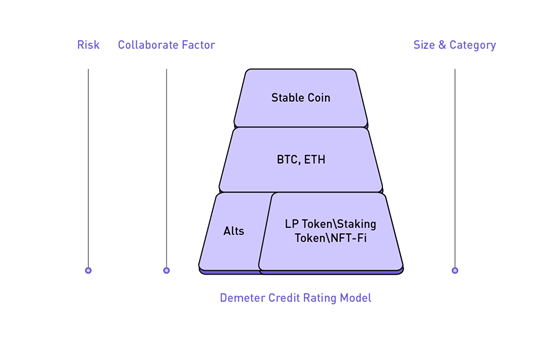
For security reasons, Demeter’s lending/stablecoin minting is established through overcollateralization. Demeter created a “line of credit”, which is established by borrowers depositing cryptocurrencies or Synthetic Assets into Demeter, and each asset has a collateral ratio that represents the loan-to-value ratio. This loan-to-value ratio reflects the value of the assets collateralized by the user and corresponds to the percentage of the loan available. Depending on the supply and demand of the assets, the interest rate for each asset is varied accordingly.
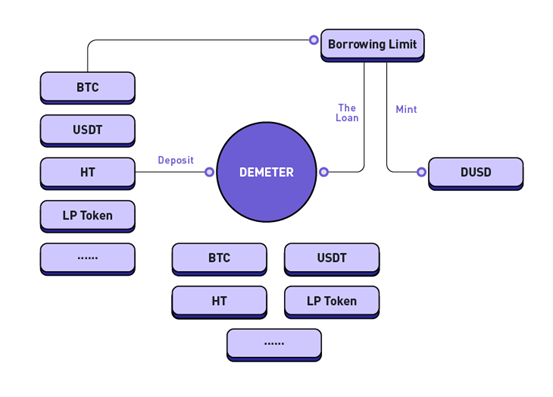
If the borrower’s available credit falls below zero, the collateral will go into liquidation and will be sold to repay the debt.
Stablecoin
DUSD is Demeter’s stablecoin. Valuing its security and sustainability, DUSD is generated by overcollateralization. Minting DUSD is equivalent to lending $1USD of debt, and the credit will be shared between minting and borrowing. The value of DUSD is backed by a basket of cryptocurrency combinations, which is not only differentiated from the collateralized fiat currencies or a single cryptocurrency on other decentralized stablecoin protocols, but also makes DUSD highly decentralized, faster, safer, more cost-efficient, and easier to use through the HECO network.
The most critical factor of a stable coin is stability, especially the 1:1 ratio with the anchor currency USD. In reality, the central banks use monetary policy as a tool to regulate the fiat currencies and maintain stability. Similarly, there is also a monetary policy belonging to the DUSD. Two regulation mechanisms are employed in this policy to better regulate DUSD and maintain its stability.
One being the Target Rate Feedback Mechanism (TRFM). When the DUSD price falls below $1, the collateral ratio for the CDP (Collateral Debt Position) decreases and less DUSD will be available for the same collateral, which corresponds to a decrease in supply. And when the price of DUSD falls below $1, the stability fee required to hold DUSD increases, so as the cost of holding it, prompting users to buy back DUSD to repay it.
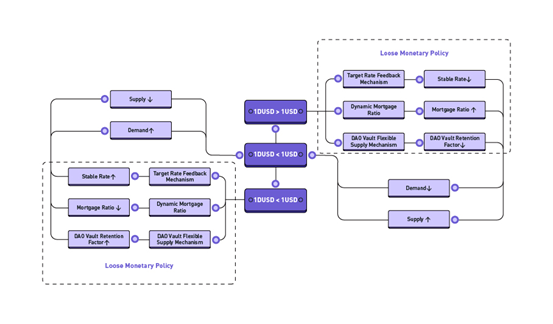
The second mechanism is the Dynamic Interest Rate Mechanism. DUSD will be supplied at a dynamic interest rate with an annual over-provision rate consistent with the stability fees, with the inflationary share going entirely to the DAO revenue pool and the DAO Treasury, without any subjective malicious increases. In addition, Demeter has set up a mechanism for the overprovision allocation rate, where a certain percentage (0%-100%) of the overprovision revenue along with a portion of the governance tokens will go into the DAO Treasury, thus ensuring that the actual annual overprovision rate is in an adjustable state.
It is important to note in particular that the dynamic interest rate supply mechanism of the DUSD is fundamentally different from the simple inflationary and algorithmic stablecoin mechanisms, where the main purpose of the excess supply of the DUSD is to hedge the endogenous growth demand of the monetary system.
These excess supply revenues do not directly enter the circulation to cause inflation, it needs to be reconciled through the Treasury first, allowing for a 0% policy target if necessary. In the case of a positive excess issue rate, the DUSD that enters actual circulation after reconciliation is also distributed through the DAO revenue pool in a completely equitable manner.
On the other hand, the excess supply of DUSD is in fact collateralized by 5% of the governance token DMT in the Treasury as collateral. When necessary, the DUSD supply can be liquidized through the Treasury governance token DMT.
In terms of liquidation, Demeter has set a liquidation penalty rate of 9% and a liquidation tax rate of 3%, which applies to both collateral lending and collateralizing stablecoins. Once a liquidator’s account goes into liquidation state, anyone can repay the debt to the system at 103% of the liquidated person’s debt and receive 109% of the collateral assets. 100% of the 103% repayment will be used by the user to repay the debt, and 3% will be fully injected into the DAO revenue pool for revenue allocation.
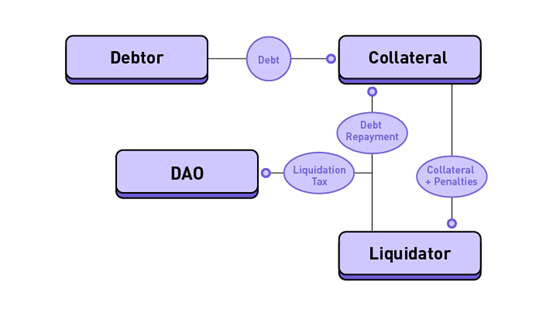
In other words, when the liquidator’s account is being liquidated, the person paying the debt on behalf of the liquidator can get 109% of the assets with 103% of the repayment, and this 6% difference will accelerate the circulation of this liquidated asset.
Dual Token System
Demeter’s dual token system consists of decentralized stablecoin DUSD and governance token DMT, which is equivalent to the role of MKR for MakerDao.
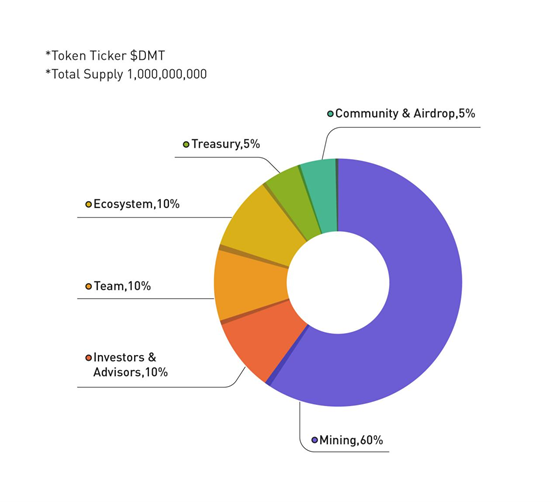
In terms of token distribution, 60% are produced by mining with 6-year output and 15% reduction per 180 days. 10% will be allocated to the team through 12 months linear unlocking. 10% are distributed to investors and advisors through 24 months linear unlocking. 10% will be allocated to the ecosystem through 36 months linear unlocking. 5% will be put into the community and airdrop with 6 years linear unlocking while the last 5% are allocated to the Treasury.
The main uses of DMT include participating in governance voting, participating in DAO revenue pool reward allocation, participating in DAO Treasury distribution, etc.
Since Demeter fully adopts DAO governance, Demeter’s governance rights are particularly important. Governance practices such as user key parameter setting and asset allocation are made via DMT’s voting decisions.
As for the distribution of rewards in the revenue pool, there are three streams: 1. All of the revenue from supplying and borrowings goes into the DAO revenue pool after withholding the necessary costs for project operations. 2. 100% of the liquidation revenue goes into the DAO revenue pool. 3. 50% of the excess supply goes into the DAO revenue pool.
Users can earn rewards by staking DMT, which is equivalent to bank deposits in the centralized world. Similarly, rewards vary depending on the term, except that staking DMT will have more flexibility as with higher returns. Staking term includes flexible access,7-day fixed term and 30-day fixed term. The incentive ratio for flexible access is 1.0, 7-day fixed term is 7.0 and 30-day fixed term is 30.0.
Conclusion
The cryptocurrency market continues to demonstrate expansion, and the DeFi market is no exception. The later stages may not come in the form of an outburst, but according to the potential of DeFi’s market performance, maintaining a linear growth pace should not a problem. Correspondingly, the demand for decentralized stablecoin market will also become greater.
Demeter’s advantages are notable and its highlights including: the aggregation of collateralized lending and collateralized minting stablecoins to achieve ultimate funding depth; dynamic interest rate supply, robustness, permissionless decentralized stablecoins; multi-asset compatibility and enhanced credit tiering for maximum capital utilization efficiency, as well as real and sustainable income sources and sharing high DAO return, etc. These advantages put Demeter in a highly competitive position in the decentralized stablecoin lending market.
Currently, Demeter has completed core functional development testing and contract auditing, and is in the process of deploying Demeter mainnet (V1) on the HECO network and launching liquidity mining. And within the year, Demeter will complete the deployment of Demeter mainnet V2, supporting the scalable Datemer bridge and cross-chain lending, extending Demeter’s frontline to ETH, BSC, Polygon and other public blockchains, building a diverse ecosystem that adapts to a multi-chain environment. By 2022, Demeter will launch graded funds and fixed income bonds. Non-standard assets bonding protocol will go live and creates a financial market that provides high liquidity for certified staking, refinancing, future cash flow bonds and convertible bonds. Demeter’s ultimate goal is to become a decentralized financial platform that combines all financial services and is not inferior to traditional financial markets.
Image by Erdenebayar Bayansan from Pixabay

















